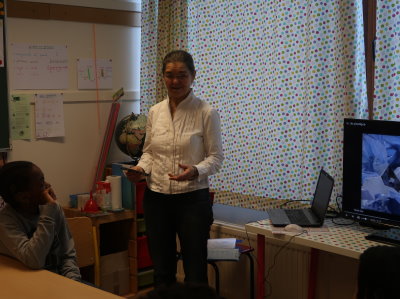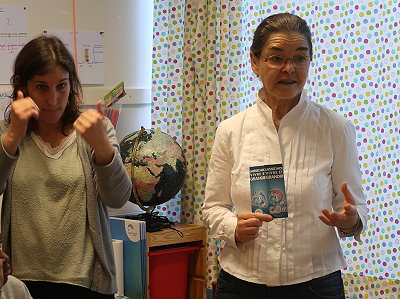 How to protect the ocean from plastic pollution? The integrated school in Sint Lambrechts Woluwe, Brussels, with its class of children with hearing problems and their teachers wanted to know more. Thus, thanks to a project of the school with the association Indigo they invited Mundus maris asbl to give a scientific course on this subject.
How to protect the ocean from plastic pollution? The integrated school in Sint Lambrechts Woluwe, Brussels, with its class of children with hearing problems and their teachers wanted to know more. Thus, thanks to a project of the school with the association Indigo they invited Mundus maris asbl to give a scientific course on this subject.
So, on the 18th of February, 2019, from 9 am to 12 noon, we went to discover what plastic pollution is, the different types of plastic, what they cause in foodwebs and in the sea and what to do for stop it.
The course began with a video showing how plastic, a material appreciated for its resistance to many conditions, has become a global threat just because of these very characteristics. Seeing these pictures, the pupils quickly began to comment on the need to stop this pollution.
 The next step was to discover the different types of plastic, how they are identified with the Moebius loop and a number in the middle between 1 and 7 indicating the material. Practical experiences helped to identify them in practice.
The next step was to discover the different types of plastic, how they are identified with the Moebius loop and a number in the middle between 1 and 7 indicating the material. Practical experiences helped to identify them in practice.
The pupils had fun separating the PET (1 - used for bottles of water and other drinks, heavier than water) which sedimented on the bottom of glasses filled with water, while the others lighter pieces of plastic then floated at the surface. One of the teachers supported the understanding by accompanying Cornelia E. Nauen of Mundus maris' oral talk with sign language.
The successive step then allowed them to separate the polyethylenes (2) and polypropylenes (5) in an alcohol solution. Polyethylenes sedimented while polypropylenes floated at the surface, because their specific weight was equal to alcohol.
The question of how long the different plastic products could stay in nature and how they disintegrated into ever smaller pieces that could then be confused with plankton or other forms of food surprised and fascinated the pupils.
 The immediate reaction of the pupils was to propose outings to pick up all the plastic objects in the surroundings and at the coast so that they do not end up in the sea through the runoff, rivers and beaches.
The immediate reaction of the pupils was to propose outings to pick up all the plastic objects in the surroundings and at the coast so that they do not end up in the sea through the runoff, rivers and beaches.
The images of the consequences and especially also the images of the organisms that make up the marine food webs triggered great interest.
Through cartons with images of different marine organisms, the pupils were able to build a foodweb in class and discuss who can eat who and how plastic can intervene in these interactions.
At the end of the course, the discussion focused on what one can do to avoid such threats to nature. The pupils then took turns writing their tips and suggestions on the blackboard. It was a good morning together. Transparencies are available here.
Text by CE Nauen, photos by P. Bottoni.








